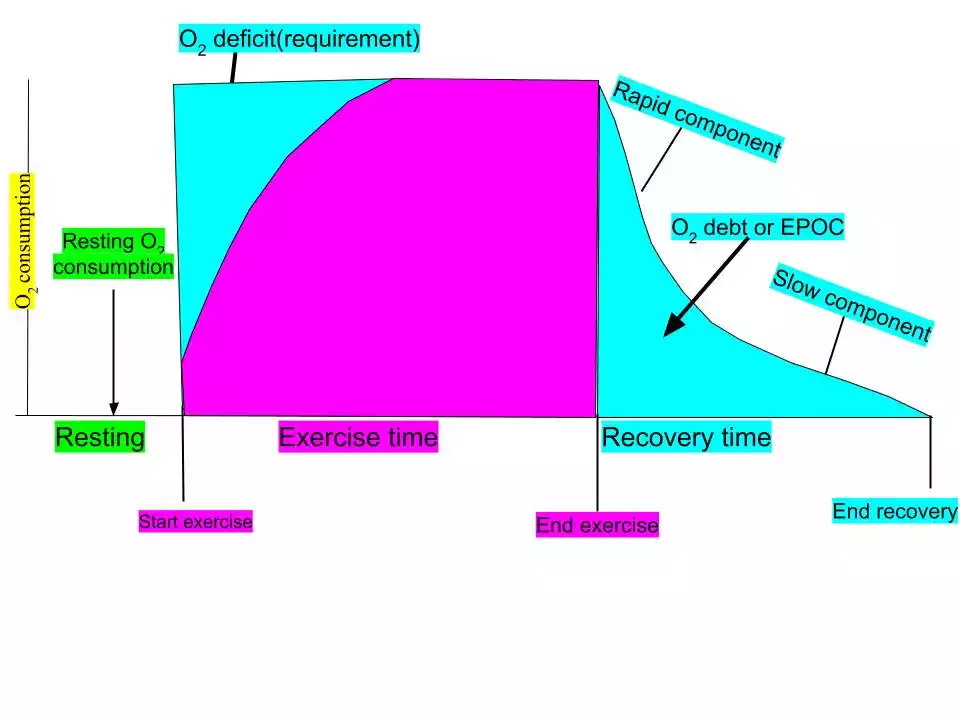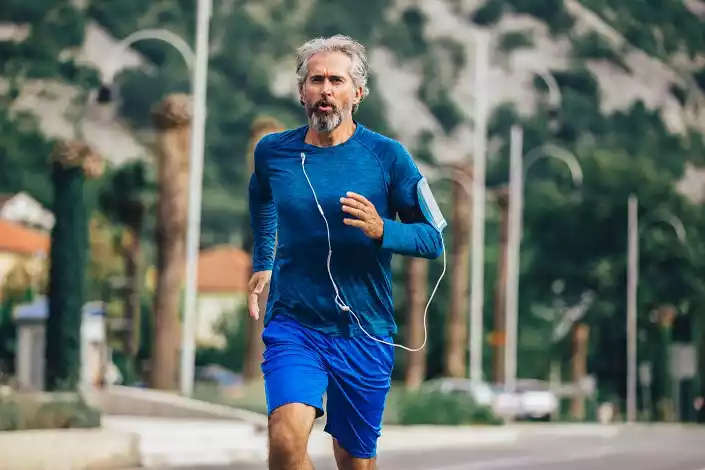The role of oxygen in the metabolism of our body is crucial, especially when we exercise. Our muscles need energy to perform physical activities. This energy is primarily obtained from aerobic processes.
Oxygen Debt and Oxygen Deficit are two physiological phenomena that occur when oxygen demand exceeds oxygen supply. Oxygen debt occurs when the body is unable to deliver enough oxygen at the beginning of exercise, or when the intensity increases suddenly.
Oxygen debt or excess post-exercise consumption (EPOC) is the extra oxygen that the body consumes after exercise to help it return to a resting state. These terms illuminate the delicate balance between oxygen demand and energy supply. This is crucial to understanding exercise physiology.
Brief overview of respiratory physiology in exercise
The respiratory system is crucial in supplying oxygen to the body when it engages in physical exercise.
This is a quick overview of the way in which your respiratory system adapts to exercise:
- Increased breathing rate (Tachypnea): Your breathing rate increases as you exercise. This helps to deliver more oxygen to your muscles and remove more carbon dioxide.
- Increased Tidal volume: You breathe faster and deeper (increased air volume per breath) when you increase your tidal volume. It helps to maximize the amount of oxygen that enters the lungs when you breathe.
- Increased Oxygen Absorption: The oxygen derived from each breath is more effective during exercise. This means that a greater percentage of oxygen from the air is delivered to the bloodstream.
- Bronchodilation: The small airways (bronchioles) in the lungs expand and allow for an increase in airflow.
- Increased blood flow: Exercise raises the heart rate, and cardiac output and ensures a faster circulation of blood. This allows oxygen-rich blood to be transported more efficiently from the lungs into the muscles.
- Oxygen Release from Hemoglobin: As the muscles work harder, their environment becomes more acidic. This encourages the hemoglobin molecule, which carries oxygen through the blood, to release oxygen.
- Capillary expansion: Blood vessel (capillaries), around the muscles, expands to provide more oxygen-rich and waste-free blood to the tissue.
- Respiratory Reserve Utilization: When we are at rest, our respiratory reserve is only a fraction of its capacity. This reserve is used more during exercise to meet the demands of the body.
- Feedback Mechanisms: The body monitors oxygen and carbon dioxide levels in the blood, and adjusts breathing rate and depth according to that. Chemoreceptors within the body respond to changes in blood chemical composition.
- Switch from Aerobic to Anaerobic Metabolism: Depending upon the intensity and duration, the body can rely more on anaerobic or aerobic metabolism. These energy systems are supported by the respiratory system.

As the intensity of exercise increases, the respiratory system adjusts to meet the increased oxygen demand and carbon dioxide production. It ensures muscles receive the oxygen needed to generate energy and maintain activity.
Importance of oxygen in metabolism
The metabolism of aerobic organisms such as humans is based on oxygen. The central role of oxygen in metabolism is centered around energy production and multiple interconnected pathways.
This is a detailed look at the importance of oxygen to metabolism:
- Cellular Respiration:
-
- Aerobic glycolysis: After glucose is converted into pyruvate by glycolysis, it enters mitochondria. In the presence of oxygen, pyruvate undergoes further metabolism in the Krebs cycle to produce energy.
- Electron transport chain (ETC): Here is where the most important ATP production takes place. The ETC’s final electron acceptor is oxygen, which is located in the mitochondria. The flow of protons is created when electrons are passed through a sequence of proteins. This results in the synthesis of ATP. The final step is to reduce oxygen in water.
- Oxidative phosphorylation: Directly related to the ETC is oxidative phosphorylation, the process that synthesizes ATP by using energy derived through redox reactions involving oxygen.
- Metabolism of Fats and Proteins: Oxygen is crucial for the metabolism of macromolecules other than glucose:
-
- Beta oxidation: Fats, in the form of fatty acid, undergo beta-oxidation within the mitochondria. This breaks them down into 2-carbon units which feed into the Krebs Cycle. This process is dependent on oxygen.
- Metabolism of Proteins: The amino acids that are produced from proteins can then be converted into molecules to enter the Krebs cycle. These molecules require oxygen to complete their metabolism.
- Detoxification: Oxygen plays a vital role in the various metabolic pathways that neutralize and eliminate toxic substances. The liver, for example, uses oxygen to break down and metabolize certain drugs and toxic substances, making it easier for the body to excrete them.
- Biosynthesis: Oxygen plays a vital role in the synthesis of many molecules and compounds within the body. In order to heal wounds, oxygen is required for hydroxylation reactions, such as collagen synthesis.
- Reactive Oxygen Species and Antioxidant System: Metabolic reactions can produce ROS like superoxide or hydrogen peroxide. ROS is important for cell signaling, but excessive amounts are harmful. The body’s antioxidant systems use oxygen to convert ROS into non-toxic compounds that protect cells from oxidative damage.
- Endocrine function: Some of the hormones are synthesized by pathways that require oxygen. The synthesis of steroid hormonal in the adrenal cortex, for example, requires molecular air.
- The role of oxygen in anaerobic metabolism: Even when oxygen is scarce, the presence or absence of oxygen can impact metabolism. In the absence of oxygen, the cells will resort to anaerobic glycolysis which produces lactic acids. This process produces less ATP than aerobic metabolism.
Oxygen is essential for many metabolic pathways, especially those that are related to energy production. Oxygen is essential for the conversion of nutrients to usable energy. It also plays a role in detoxification, biosynthesis, and other metabolic processes.
Basics of Oxygen Consumption during Exercise
Oxygen consumption during physical activity reflects your body’s ability to transport and use oxygen to meet the increasing energy needs of working muscles.
Oxygen consumption increases as exercise intensity increases. Let’s start with the basics:
- Aerobic Metabolism:
-
- ATP is needed to fuel muscle contractions during exercise. While ATP can also be produced anaerobically in cells, aerobic metabolism is the most efficient method to produce it for prolonged activity.
- Aerobic metabolism is the oxidation (of glucose from carbohydrates or fats) in the presence of oxygen. This produces ATP, CO2, and water.
- Oxygen uptake (VO2):
-
- Vo2 Max: The maximum amount of oxygen that an individual can use during intense exercise is VO2 max. It is a measure of cardiovascular and aerobic fitness.
- Submaximal Vo2: The oxygen intake rates are below the VO2 maximum. The intensity and type of exercise will determine the VO2 max.
- Oxygen delivery and utilization:
-
- Delivery: The delivery of oxygen involves the transport of oxygen to the active muscles by the cardiovascular system.
- Utilization: The muscles’ ability to extract and use oxygen is measured. This is determined by factors like mitochondrial density and enzyme activity in the muscle cells.
- Oxygen Consumption Curve:
-
- As soon as you begin exercising, your oxygen consumption increases rapidly. This increase eventually plateaus once you reach a steady state (assuming that the intensity is constant and submaximal).
- Oxygen consumption will increase if the intensity of exercise increases abruptly. This will continue until a new stable state is reached.
- Oxygen consumption does not immediately return to baseline after exercise. It gradually decreases as a result of processes such as recovery and repayment of “oxygen debt.”
- Factors Influencing Oxygen Consumption:
-
- Exercise Intensity: Oxygen Consumption increases linearly as exercise intensity increases up to VO2 Max.
- Exercise duration: When exercising for a long time, and especially after glycogen is depleted, the metabolism shifts from carbohydrates to fat, which requires greater oxygen.
- Training Status: A trained individual has a higher maximum oxygen consumption due to increased capillary density and mitochondrial function.
- Altitude: As altitude increases, oxygen is less available, so the body has to work harder to provide adequate oxygen to muscles. This affects oxygen consumption dynamics.
- Anaerobic Threshold:
-
- Also called the lactate threshold. When exercise intensity increases to a certain point, oxygen cannot meet energy demand, resulting in an increase in anaerobic metabolic rate.
- This threshold is where lactic acid begins to accumulate more quickly in the blood. It indicates that the body has a limited ability to remove and process it. This is a crucial marker for endurance athletes as fatigue can set in much faster if they work beyond this threshold.
Understanding the oxygen consumption of the body during exercise can provide insight into how it responds to different intensities and durations. Exercise science relies on it to help professionals create training programs, assess fitness levels, and optimize performance.
Definition of Oxygen Deficit
Oxygen Deficit
Oxygen deficit is the difference between how much oxygen you need to do a certain exercise aerobically, and how much oxygen you actually use during the first stages of the activity. It’s the difference between the amount of oxygen required to perform a particular exercise aerobically and the actual amount of oxygen used during the initial stages.

Key points:
- Exercise Start: The body’s oxygen demand increases suddenly at the start of an exercise. Oxygen uptake is not at the same level as the increased intensity of the work. The oxygen deficit is caused by the lag between immediate demand and uptake.
- Contribution Anaerobic: Due to this initial lack of oxygen, the body relies on anaerobic energy pathways (without oxygen) to produce ATP. This is especially true from stored ATP and creatine phosphate. This causes an accumulation of lactic acids in the muscles.
- Transition phase: The oxygen deficit occurs primarily during the transition between rest and steady-state exercise, or when moving from a low intensity to a high intensity. Once the steady state has been reached, aerobic processes are able to provide most of the energy needed for the activity if the intensity is not above the lactate threshold.
- Untrained vs. Trained: The oxygen deficit of trained individuals is smaller than that of untrained individuals. This is due to the fact that trained individuals have a more efficient cardiovascular system and muscular system, which allows them to increase oxygen uptake faster at the beginning of exercise.
The oxygen deficit is the difference between ideal and actual oxygen consumption in the early phases. This highlights the body’s initial dependence on anaerobic metabolic processes before aerobic mechanisms are fully able to respond.
Definition of Oxygen Debt
Oxygen Debt
Excess post-exercise oxygen consumption is also known as Oxygen Debt. It refers to an elevated rate of oxygen consumption following strenuous exercise. It is the amount of oxygen needed to return the body to a resting state, and to compensate for any oxygen deficit that occurred at the beginning of exercise.
Key points:
- Recovery: Even after exercise has ended or the intensity has been reduced, the metabolic rate of the body remains elevated for some time. The body is trying to recover from the physiological disturbances caused by exercise. Oxygen debt is manifested during this recovery phase where oxygen consumption exceeds baseline resting levels.
- Two phases of EPOC:
-
- Fast component: This happens immediately after exercising and lasts about an hour. This phase is characterized by rapid decreases in oxygen consumption. This phase involves the resynthesis and phosphate of stored ATP, as well as the restoration of oxygen in venous and muscle blood.
- Slow component: The slow component is the phase that can last several hours, and it’s characterized by an oxygen consumption reduction that takes longer. It is responsible for processes such as increased heart rate, body temperatures, and respiratory rates, increased protein turnover and lactate conversion into glucose in the liver.
- Factors that Affect Oxygen Debit: The severity and duration of EPOC may vary depending on factors such as:
-
- Exercise intensity: More intense exercises usually result in an oxygen debt that is greater.
- Exercise Duration: Extended periods of EPOC can be caused by longer exercise sessions.
- Types of Exercise: High-intensity interval training (HIIT), resistance training, or steady-state aerobic exercise may result in an EPOC that is more pronounced than with steady-state exercises.
- Untrained vs. Trained: Although trained individuals recover faster after exercise, they may also accumulate more oxygen debt because of their increased ability to exert themselves at a higher intensity.

The extra oxygen that the body consumes after exercise, in addition to the resting oxygen consumption rate, is due to the physiological processes the body goes through to recover and get back to the pre-exercise condition.
Oxygen Debt and Oxygen Deficit in the comparison chart
Certainly, let’s create a comparative chart for Oxygen Debt and Oxygen Deficit:
| Feature | Oxygen Deficit | Oxygen Debt (EPOC) |
|---|---|---|
| Definition | The difference between the amount of oxygen required for a given exercise intensity and the amount actually utilized during the initial stages of that exercise. | The elevated rate of oxygen intake after strenuous activity, needed to restore the body to its resting state. |
| Occurrence | At the onset of exercise. | After the cessation of exercise or during reduced intensity following high-intensity exercise. |
| Duration | Short-lived (initial phase of exercise). | Can extend for several hours post-exercise, depending on the intensity and duration of the activity. |
| Physiological Implication | Body relies more on anaerobic pathways due to immediate shortfall in oxygen supply. | Body is restoring physiological processes to baseline, replenishing energy reserves, converting lactate to glucose, etc. |
| Associated with | Anaerobic energy production, lactic acid buildup. | Resynthesis of ATP & creatine phosphate, restoration of oxygen levels, glycogen replenishment, elevated heart rate, etc. |
| Effect of Training | Trained individuals typically have a smaller oxygen deficit due to efficient aerobic systems. | Trained individuals can have a larger oxygen debt because they can exercise at higher intensities, but they also recover quicker. |
| Visual Representation | Illustrated as the gap between the ideal oxygen uptake curve and the actual uptake at the start of exercise. | Represented by the elevated curve of oxygen consumption after exercise stops, before it returns to resting levels. |
This comparison chart outlines the primary differences and characteristics of oxygen deficit and oxygen debt. Both concepts are crucial in understanding the body’s physiological response to varying exercise intensities and durations.
Consequences & Physiological Implications
Understanding exercise physiology requires an understanding of both oxygen deficit (EPOC) and oxygen debt. Both the physiological and psychological implications of each play a crucial role in determining how the body responds to different intensities and durations of exercise.
Oxygen Deficit:
- Anaerobic energy production:
-
- As a result of the immediate lack of oxygen, the body relies on anaerobic pathways to provide energy (like the ATP-PC System and glycolysis).
- Lactic Acid build-up:
-
- The accumulation of lactic acids in the muscles can lead to fatigue and discomfort.
- Short-term Energy Supplies:
-
- Once oxygen is available, the body will use stored ATP and creatine phosphate. These are quickly depleted.
- Inefficient energy production:
-
- Anaerobic pathways have a lower efficiency than aerobic pathways. They can be a quick source of energy but are not long-lasting.
Oxygen Debt (EPOC):
- Restoring Physiological Balance:
-
- This involves processes like rebalancing the ion concentrations in and outside of muscle cells, and restoring pH levels affected by lactic acid production.
- ATP Resynthesis and Creatine Phosphate Synthesis:
-
- The body uses excess oxygen to replenish the immediate energy reserves, namely ATP or creatine phosphate.
- Lactate to Glucose Conversion:
-
- In a process known as the Cori cycle, the liver absorbs lactate from the blood and converts it into glucose or glycogen. This process needs oxygen.
- Elevated heart and respiratory rate:
-
- Even after the exercise is over, the heart rate and respiration rate continue to be elevated in order to remove the carbon dioxide and other metabolic products and provide oxygen.
- Increased body temperature:
-
- Exercise increases the internal body temperature. After exercise, thermoregulation processes like sweating continue. This can increase oxygen consumption.
- Fatty acid Oxidation:
-
- After exercising, the body becomes more dependent on fat for fuel, which requires oxygen.
- Hormonal changes:
-
- Exercise releases hormones such as adrenaline and cortisol. These hormones increase metabolic rate, and oxygen consumption, during the recovery phase.
Oxygen deficiency leads to a short-term and immediate reliance on anaerobic routes at the beginning of exercise. This can lead to consequences such as lactic acid accumulation. Oxygen debt, on the other hand, is a collection of recovery processes initiated by the body after exercise to restore physiological equilibrium, replenish energy reserves, and prepare for further physical demands.
Real-world examples & Applications
There are many real-world applications and implications of understanding oxygen deficit and debt (EPOC), especially in sports, health, and fitness.
Here are some examples of real-world applications and their implications:
Oxygen Deficit:
- Sprinters and Athletics:
-
- Imagine an athlete who bursts from the blocks at full speed. The short race duration (less than 10 seconds for sprinters) does not allow the aerobic system time to respond fully. Energy is primarily derived from anaerobic systems, namely the ATP-PC.
- High-Intensity Interval (HIIT) Training:
-
- HIIT is a workout that alternates between high-intensity exercises and periods of rest or low-intensity exercise. The body cannot supply enough oxygen during those intense bursts. This leads to an oxygen deficiency and anaerobic metabolic reliance.
- Powerlifters:
-
- Another example of an activity that heavily relies on anaerobic processes is a powerlifter that attempts a max one-rep lift. This is due to the oxygen deficit during such a short and intense effort.
Oxygen Debt (EPOC):
- Afterburn after a workout in fitness:
-
- Fitness enthusiasts refer to “afterburn”, where the body continues burning calories at a high rate after exercise. EPOC is responsible for a large part of this phenomenon. After a HIIT or weightlifting session, you may notice a higher metabolic rate lasting several hours. This leads to more calories being burned.
- Recovery of Endurance Athletes:
-
- While the runner may be resting, their body will continue to consume oxygen. EPOC is the body’s attempt to repair muscle tissues, replenish energy reserves, and restore equilibrium.
- Recovery Session in Sports Training:
-
- After high-intensity days of training, sports teams will often include low-intensity sessions for recovery. These sessions can help reduce oxygen debt, by removing lactic acid. They also facilitate recovery.
- Weight Loss Programs:
-
- Understanding EPOC was crucial when designing weight loss programs. Exercises that cause a large oxygen debt, such as HIIT and strength training, can have a greater impact on overall calorie burning due to an extended period of metabolic rate increase post-exercise.
Oxygen deficit and debt are more than just concepts. These principles are actively involved in training methods, athletic performance, and recovery strategies. Understanding these processes helps athletes, coaches, and fitness professionals optimize training, improve performance, and facilitate recovery.
How to Minimize Oxygen Deficit and Debt
It is possible to improve exercise performance by minimizing oxygen deficits and debts. This can also optimize energy efficiency and reduce recovery time.
Here’s a way to address both:
Minimizing Oxygen Deficit:
- Warm-Up:
-
- Warming up properly increases the heart rate, respiration rate, and blood flow into muscles. The aerobic system is prepared to handle the intensity of the next activity.
- Aerobic Exercise:
-
- Aerobic exercise such as running, cycling, or swimming improves cardiovascular efficiency and lung capacity. It also increases blood volume. It allows for quicker oxygen delivery and uptake during the transition from rest to activity.
- Acclimatization:
-
- Spend time acclimatizing if you are training or competing in high altitudes. As you climb higher, oxygen availability decreases. This leads to an oxygen deficit. Gradual acclimatization helps the body to become more efficient in utilizing oxygen.
- Optimal Pacing:
-
- Starting too fast in endurance events can cause a significant oxygen deficiency, which makes it difficult to maintain performance. The right pacing will ensure that oxygen supply and demand are more closely matched.
Minimizing Oxygen Debt (EPOC):
- Gradual Cooldown:
-
- To help your body return to rest, instead of stopping abruptly following intense exercise, do a low-intensity activity (like slow cycling or walking). This will help reduce the oxygen debt.
- Stay Hydrated with:
-
- A good hydration regime can help to speed up metabolic processes and remove waste products efficiently. This could reduce the duration of EPOC.
- Active recovery:
-
- Swimming or cycling in low intensity can improve blood circulation and help remove lactic acids faster. This could reduce oxygen debt.
- Adequate Nutrition:
-
- After exercise, consuming carbohydrates and protein can help restore glycogen and repair muscle. EPOC can be affected by the amount and duration of carbohydrates consumed.
- Avoid Overtraining:
-
- Exercises that are high-intensity and repeated without sufficient recovery can cause prolonged periods of increased oxygen consumption. Balance high-intensity workouts with days of rest or low-intensity to ensure full recovery.
- Improve Aerobic Fitness:
-
- Improved aerobic capacity will also reduce oxygen debt. Well-trained aerobic systems can recover quicker after exercise.
Individuals can improve their performance and recover faster by optimizing the body’s use of oxygen at the beginning of exercise and managing the recovery process afterward.
Conclusion
Understanding the dynamics of the oxygen deficit and the oxygen debt in the world of exercise science is critical for optimizing recovery and performance. Oxygen debt highlights the body’s temporary dependence on anaerobic sources of energy due to the immediate challenge it faces in meeting oxygen requirements at the start of exercise.
Oxygen debt, on the other hand, highlights how hard the body works to recover and restore balance after exercise. By utilizing strategic warm-ups and recovery techniques, you can reduce these effects, leading to more efficient workouts. These principles can help you achieve better athletic performance as well as a healthier body.
References books
Here are some foundational and authoritative books in the realm of exercise physiology and related fields that could serve as references:
- “Exercise Physiology: Nutrition, Energy, and Human Performance”
-
- Authors: William D. McArdle, Frank I. Katch, and Victor L. Katch
- Description: A comprehensive textbook that covers various aspects of exercise physiology, from basic biochemistry to advanced topics in performance and health.
- “Exercise Physiology: Human Bioenergetics and Its Applications”
-
- Authors: George A. Brooks, Thomas D. Fahey, and Kenneth M. Baldwin
- Description: An in-depth exploration of the bioenergetics of exercise and the impact of exercise on human health and performance.
- “Textbook of Work Physiology: Physiological Bases of Exercise”
-
- Authors: Per-Olof Astrand, Kaare Rodahl, Hans A. Dahl, and Sigmund B. Strømme
- Description: A classic in the field, this book offers a deep dive into the physiological principles underlying human performance at work and during exercise.
- “Principles of Anatomy and Physiology”
-
- Authors: Gerard J. Tortora and Bryan Derrickson
- Description: While not exclusively focused on exercise, this is a foundational text for understanding human anatomy and physiology, which is crucial for diving deeper into exercise-specific topics.
- “Advanced Nutrition and Human Metabolism”
-
- Authors: Sareen S. Gropper and Jack L. Smith
- Description: This book provides a detailed overview of human metabolism, which is key to understanding how the body processes nutrients during exercise and recovery.
These books are excellent starting points for anyone looking to delve deeper into exercise physiology, nutrition, and human performance. They are commonly used in academic settings for exercise science and related programs. If you’re researching specific topics, these references should provide a solid foundation.

